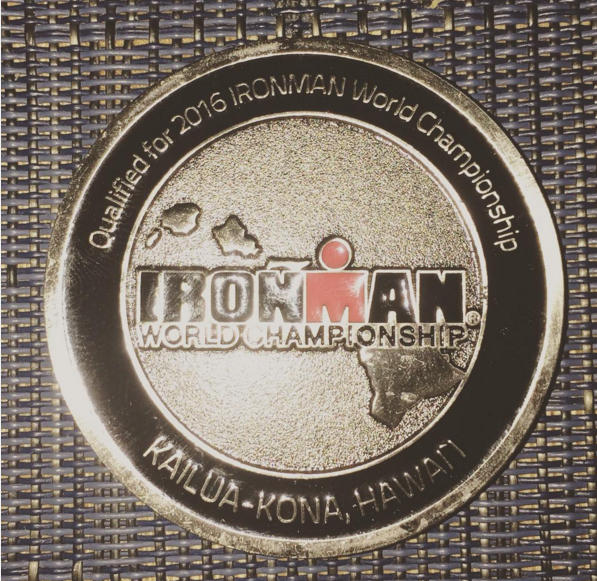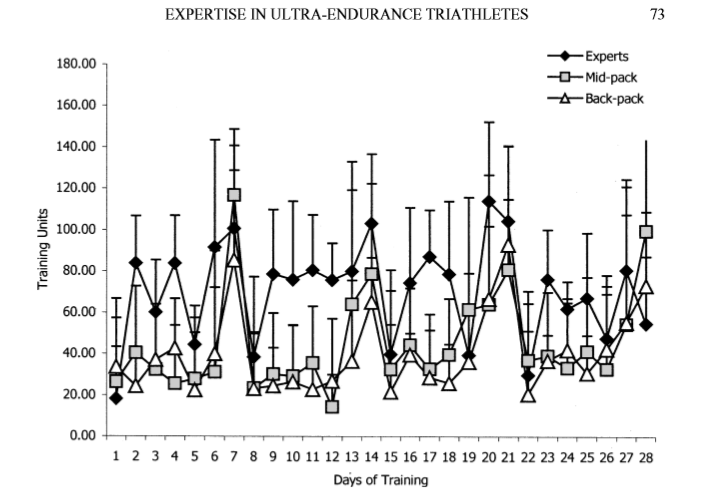The Kona Qualifier's Basic Week
Alan Couzens, M.S. (Sports Science)
Oct 29th, 2015

"There is a place for the 8hr a week athlete. It is the job of the coach to sell the dream to the athletes doing 10-12hrs a week and persuade them to commit to the 18-24hrs a week that they need to become truly competitive"
- Bill Sweetenham (former national coach of the Aussie swim team)
Well here goes… :-)
Around this time of year I receive a lot of inquiries from prospective new athletes after they get fired up after following the Ironman World Championships in Kona. Maybe you were watching a buddy on the live feed & Greg Welch or Michael Lovato’s enthusiasm got to you or it reminded you of those goosebumps you had last year when Al Trautwig’s voice cracked watching the slow mo of finisher’s crossing the hallowed finish line on Alii Dr. I get it. There is something entirely magical about that race that sets it apart from other races. The beauty & uniqueness of the island and the level of competition. It goes without saying that securing a slot to the World Championship of our sport isn’t easy. For many, it is this factor that makes the challenge so appealing.
Unsurprisingly, many of the athletes who feel this lure of the Kona challenge are life-wide Type-A uber-competitive folks who see Kona as the next logical goal progression in their chosen sport . By ‘life-wide’, I mean many of these individuals are high performing in other areas of their life as well, e.g. in their chosen vocation – CEO’s, financial advisors, Doctor’s, Lawyers etc. What is the common thread among individuals at the peak of these professions? Time.
As the old saying goes, you can have anything you want but not everything you want. Priorities must be set & choices must be made.
These individuals have no problem working hard. It’s their defining characteristic! Getting up before sunrise to get the training in, staying up late to get that turbo session done but there is often an unrealistic assessment of just what level of performance this ‘squeezing sessions in’ will get them.
When an athlete throws out this goal in an 'off the cuff' manner e.g. Me:"So what are your goals?" Them:"Well, Kona, of course." I think back to that old MTV show motto – “You think you know, but you have no idea.”
And it’s not your your fault. There is a whole big business industry of pre-fabricated ‘time crunched’ programs that promise (& heavily market) FOP results on a BOP time investment. They’ll probably even throw in a set of Ginsu steak knives if you ask nicely! -- 'But wait, there's more...' :-) In the interests of bringing some truth back into the mix, here’s the reality: Qualifying for Kona is hard and it's getting harder...
.@MrSmiths_Coach That article and those numbers are a few years old now. Mean CTL for my 2015 qualifiers was 158 - i.e. significantly higher
— Alan Couzens (@Alan_Couzens) October 11, 2015At a typical qualifying race there will be 40-50 slots for 2000-3000 athletes, i.e qualifiers are in the top 2% of the field. For the less mathematically inclined, if we randomly pull 50 athletes, you have to be number 1 - the best among them. It shouldn’t come as a surprise that the 1 is a little different to the 49. However, it may not be in the way that you’re thinking.
After working with these guys for a long time now, I have to conclude that, for the bulk of qualifiers, it is not genetics that sets them apart. It is the way that they live their lives and the way that they consciously structure their lives around their goals. Put more plainly, these guys get the training done.
The rest of this post will go on to answer that follow up question that many of you fellow working athletes have – How?
As a long time coach of these athletes, I know the typical training load that these guys are laying down – I prescribe it! And, as you know, I love to quantify things and talk about all of these numbers - CTL, TSB, TSS, that's my jam! :-) However, load and CTL numbers don’t really tell the story in all its richness. That CTL of 150+ amounts to countless 3-4hr ‘bread and butter’ training days. Behind these numbers are thousands of life choices that an athlete makes on how to schedule their week and allocate their time to the things most important to them. Choices that separate them from the other 98% of athletes in the race. Exhibit A…
I pulled the following data direct from Training Peaks. These weeks represent the session averages for the loading weeks of 2 of my kona athletes in the 3 months leading in to the taper for Kona. The schedule is an average of the actual ‘time of day’ start times as recorded by their Garmin for each of the weekly sessions for those 3 months. I have also included average intensity (in HR) for each session. For context, Athlete A has an AeT HR 130bpm for both bike & run. Athlete B has an AeT HR of 120bpm on the bike and 125bpm on the run. Athlete B had a running injury leading into the race so run numbers are a little lower than I would typically prescribe.
Athlete 1 - Average loading week for the last 3 months leading in to taper for Kona...

Athlete 2 – Average loading week for the last 3 months leading in to taper for Kona….

What can we glean from this?
- The guys at the front of your age-group train a lot. No real surprises there.
- They do a lot of training in and around AeT.
- They get up early (but not too early) & get a chunk of their training done ‘first thing’ when energy & available time is still high. – in Covey-speak, they place their big rocks first.
- They make good use of their lunch hour (& are able to negotiate for a long lunch). Don't call them after lunch -- they'll be eating! :-)
- They have at least one additional day per week (in addition to their standard big weekend training) where they can go long (or frequent camps during the most important months that make up for these big days).
- Summing it all up: The guys at the front of your age-group typically have somewhat flexible schedules that allow them to devote significant ‘blocks’ of time through the week to Ironman specific training.
Of course, the above only represents a sample of 2 athletes that I deliberately selected from my KQers as a representation of what I consider typical or ‘average responders’. I have certainly had a handful of ‘high responders’ qualify on significantly less volume than the above. Are you maybe one of those fortunate few? Have you qualified yet? Then probably not. But you can go here for a little more info on that. However, to add a little more data to back up the small sample presented above, similar patterns have been shown on a larger scale. A 2002 study by Baker et al. on 28 ultra endurance athletes found the following differences in the weekly training pattern between expert, middle-of-pack and back-of-pack athletes…

Adding a little more context on the level of athletes in the study….
- Experts = average finish time of 9:21 – 2SD above mean.
- Mid-pack = 12:02
- Back-pack = 15:03 – 2SD below mean.
While the study confuses things a bit by using arbitrary load units, it’s easy to get some ‘real world’ context by looking at the weekend. Every long course athlete goes long on the weekend – Front o’ packers, Back o’ packers. Nothing special there. The thing that separates the experts from the non is what happens during the week. If we assume that the peak day of 120 u is ~a 6hr day, that would bring the BOPers in at just over an hour a day for their mid-week sessions, while the FOPers are getting a lot of 3-4 hr days in during the week. These numbers line up well with the actual logs that I pulled from my own FOPers above.
Baker and colleagues identified this as a key differentiator…
“The lines for the mid-pack and back-pack groups indicate training load was significantly lower during the week than during weekend sessions. For the experts, there was much less of a division…”
At the peak of your ‘professional life’ it’s easy to get the impression that every one is as busy as you working their 10 hour days to ‘make ends meet’. While that may make up a good chunk of the Type-A population, it doesn’t make up the bulk of the guys who hit the big island each October. Through choice, or competitive necessity, these people have made the conscious decision to devote a significant portion of their time and life to their sport.
I present this information not as a suggestion that this is ‘the right way’ to live or as a recommendation that you need to replicate this schedule at this point in your life. I firmly believe that maintaining the physical training necessary to complete an Ironman triathlon, at any level, offers significantly more lasting value (to long term health and fitness) than a one off KQ medal!
Nor, do I suggest, even if a KQ is your aim, that 'jumping into' a week like this will automatically lead to a KQ. These weeks represent the 'peak' of a longer term (year or more) gradual progression to this point. In the absence of the right 'lead in' training, these weeks are more likely to lead to overtraining or injury. I outline this longer term process of building to this point here
But… for those of you who have felt the call of the island & decided to take on that next level challenge, I offer the above as a reminder of the space you will need to set aside in your life and as a reality check to offset the marketing hype of the ‘get to Kona on 10hrs a week’. Furthermore, I offer it as a reminder that there are, indeed, regular (non genetically 'gifted'), working folk out there who have set and achieved a goal to create the space in their life to facilitate this type of consistent weekly schedule. Folks who have prioritized carving out space within their life to pursue their passion. Unless you are a very naturally gifted athlete, it will be tough for you to compete with these athletes without doing the same.
I present this not to discourage you, merely to have a realistic appraisal of where you are on your own journey. On the contrary, I hope this peek into the life of guys at the top of the sport is encouraging! As it turns out, the bulk of the guys ‘crushing’ your age-groups aren’t genetic freaks, they’re just people who have decided to live a little differently to ‘the norm’.
After working with & being fortunate enough to be a part of these guys journeys for the better part of 2 decades, I have to say, there are far worse ways to live.
Live smart (& with passion),
AC
Tweet